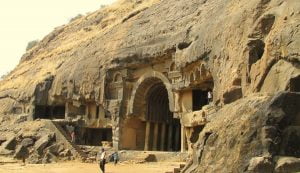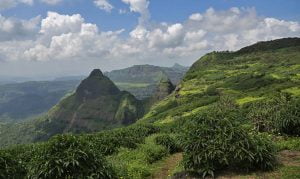Bhaja Caves
Interesting Facts about Bhaja Caves
A Short Trip to the Bhaja Caves
Located at Pune, near Lonavala (Maharashtra), Bhaja Caves, also known as Bhaje Caves date back to the 2nd century BC. These rock-cut caves stand straight at a height of 400 feet above the village of Bhaja after which it is named. The significant features of the Bhaja Caves and the stupas are really eye-catching and reveal a lot about Indian history during its time. Bhaja Caves is a must-go for people planning a trip to Maharashtra.
The architecture of Bhaja Caves
The most prominent sculpture of this cave is the Chaitya or Chaityagrha which reveals wonder of wooden architecture during those days. The Chaitya is a monument of wooden architecture with a vaulted horseshoe arched entrance as declared by the Archaeological Survey of India. It is one of the earliest among its types. The sculptures inside the cave reveal the use of tabla about 2000 years ago in Indian culture. Chaitya has Buddha reliefs along with unique reliefs from Indian mythology. A wooden beam inside the cave is inscribed with the names of donors of those times along with two more dates from the 2nd century B.C. The cave at the end has a picturesque waterfall from which water during monsoon fills a small pool at the bottom of it.
The Eye Catchers
A group of 14 stupas of the Bhaja Caves, five inside and nine outside an irregular excavation is the breathtaking landscape of this place. These stupas are the creations of the monks, who lived in the caves and died at Bhaja and display an inscription with the names of three monks, Ampinika, Dhammagiri, and Sanghdina. The stupas mainly display the names of the monks and their respective titles. The stupas have been carefully and elaborately carved such that two of them have a relic box on their upper side. Names of monks have been titled with Theras.
The “SURANG”
- As mentioned earlier, the Bhaja Caves are comprised of a number of caves.
- One of them is an irregular vihara, about 14 feet square, having two rooms on each side and three on the rear part. The chaitya is decorated with ornaments all over the doors.
- Rail pattern ornament, broken animal figures, and the verandah on the frontal side look similar to the Pandavleni Caves.
- The chaitya at Bhaja Caves is one of the earliest surviving chaitya halls, constructed in the second century BC. It has an ‘apsidal hall with stupa’. The columns slope inwards in the imitation of wooden columns that are most probably necessary to keep a roof up. The ceiling was faced with a wooden facade which has completely perished now.
- The rail pattern is noticeable, a few cells at the back, and a bolt door system is found at the back.
- This cave facing north is about 6 feet 8 inches wide and 25.5 feet deep, with 7 cells. Stone benches, square windows, and stone beds are the key features of these cells.
- It can be reached by stairs to the south of this cave. It is a small vihara 12.5 wide and 10 feet deep having a couple of semi-circular niches and a bench by its side.
- There is another cave that looks like a small vihara. It is 18.5 feet long and 12.5 deep, with 5 cells, one of the cells has a bench in it. It has two inscriptions in it one of which is damaged. Cell door inscription portrays “the gift of the cell from Nagasawa, a Naya of Bhagwati”. There is an inscription over the two wells in a recess describing “a religious gift of the cistern by Vinhudata, son of Koski, a great warrior.”
The final cave or the last cave is a monastery with a verandah. The door has guardian figures on both of its sides. All in all, Bhaja Caves is one of the oldest caves in India and one of the most important heritage monuments portraying Indian Culture and art form dating back to 2000 BC.
Places to see around Bhaja Cave
Karla Caves:

The Karla Caves are a series of ancient rock-cut temples located 15 km from Bhaja Caves. These Buddhist shrines are considered to be among the earliest examples of rock-cut architecture in India and are a popular tourist attraction for history and religion enthusiasts. Visitors can explore the intricate carvings and sculptures within the caves, admire the beautiful chaitya hall and learn about the rich history and culture of ancient India.

Lonavala is a popular hill station located 35 km from Bhaja Caves. Known for its picturesque scenery and scenic waterfalls, Lonavala is a popular tourist destination for nature lovers and adventure enthusiasts. The hill station is surrounded by lush green forests and rolling hills, making it the perfect destination for trekking, hiking, and nature walks. Visitors can also enjoy boating and picnicking at the many lakes in the area or explore the numerous temples and historical sites.
Bhushi Dam:
Bhushi Dam is a popular picnic spot located just 10 km from Bhaja Caves. This scenic dam is surrounded by beautiful hills and rolling countryside, making it the perfect destination for a peaceful day out. Visitors can enjoy boating, fishing, and swimming in the calm waters of the dam or take a leisurely walk along the banks and admire the stunning views.
Shrivardhan Beach:
Shrivardhan Beach is a pristine and serene beach located 50 km from Bhaja Caves. This beautiful beach is known for its clear blue waters, soft sand, and lush vegetation. Visitors can enjoy a day out at the beach, soaking up the sun and swimming in the calm waters or explore the nearby fishing villages and markets.
Pawna Lake:
Pawna Lake is a stunning artificial lake located just 30 km from Bhaja Caves. This beautiful lake is surrounded by rolling hills and lush greenery, making it the perfect destination for boating, camping, and picnicking. Visitors can enjoy the peaceful and serene atmosphere of the lake, admiring the stunning views and soaking up the beauty of nature.
Visapur Fort:
Visapur Fort is a historic fort located just 10 km from Bhaja Caves. This magnificent fort is known for its challenging trekking trails, stunning views, and rich history. Visitors can explore the fort’s ruins, admire the beautiful views from the top, and learn about the rich history of the fort.
Tiger’s Leap:
Tiger’s Leap is a popular viewpoint located just 30 km from Bhaja Caves. This breathtaking viewpoint offers stunning views of the valley below and is famous for its panoramic views of the surrounding countryside. Visitors can enjoy a leisurely walk to the viewpoint, admiring the stunning scenery along the way and taking in the beauty of the surrounding hills.
Rajmachi Wildlife Sanctuary:
Rajmachi Wildlife Sanctuary is a protected forest area located just 40 km from Bhaja Caves. This diverse sanctuary is home to a variety of wildlife species, including leopards, tigers, and many species of birds. Visitors can enjoy trekking and hiking through the lush forests, exploring the diverse wildlife and admiring the stunning views of the surrounding countryside.
How to reach
Bhaja Caves are located in Pune, Maharashtra, India. Here are the various modes of transportation to reach Bhaja Caves:
- By Air: The nearest airport to Bhaja Caves is Pune International Airport, which is located approximately 60 km away. From the airport, visitors can hire a taxi or take a local bus to reach Bhaja Caves.
- By Train: The nearest railway station to Bhaja Caves is Pune Railway Station, which is located approximately 45 km away. From the railway station, visitors can hire a taxi or take a local bus to reach Bhaja Caves.
- By Bus: Bhaja Caves are well connected by road and are easily accessible by local buses. Visitors can take a local bus from Pune to reach Bhaja Caves.
- By Car: Visitors can also rent a car or hire a taxi from Pune to reach Bhaja Caves. The journey takes around an hour and is a scenic drive through rolling hills and lush greenery.
It is advisable to carry a map or GPS device as the caves are located in a remote area and can be difficult to find without proper directions.
Best time to visit
The best time to visit Bhaja Caves is between October and March. During this time, the weather is pleasant, and visitors can enjoy comfortable temperatures and clear skies. The monsoon season in India, which usually lasts from June to September, is not the best time to visit Bhaja Caves as the caves can become slippery and dangerous during the rainy season.
Visitors can also avoid the peak tourist season, which is usually during the summer months when temperatures can get quite hot. During the winter months, the skies are clear, and the views of the surrounding countryside are at their best, making it an ideal time to visit Bhaja Caves. Overall, the best time to visit Bhaja Caves is during the winter months when the weather is pleasant and the crowds are minimal.



